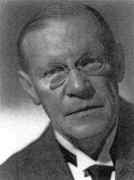Person: Speiser, Andreas

Andreas Speiser was a Swiss mathematician and philosopher of science who worked in number theory, group theory and the theory of Riemann surfaces. He was also interested in the history of mathematics.
Mathematical Profile (Excerpt):
- Speiser's school education was in his home city of Basel and he graduated with his baccalaureate certificate from the Gymnasium at Easter 1904.
- Von der Mühll advised Speiser to study at the University of Göttingen and, having entered in 1904, he was taught by several leading mathematicians including Felix Klein, David Hilbert and Hermann Minkowski.
- While he was studying there he became friends with Constantin Carathéodory who had been a student of Minkowski's and was a docent at Göttingen for most of the time Speiser was studying there.
- Speiser undertook research on quadratic forms advised mainly by Minkowski but also helped by Hilbert.
- Speiser's oral examination, which took place on 3 March 1909, was conducted by David Hilbert.
- After being examined on his thesis, Speiser went to Britain where he spent time in London but also visited Edinburgh in August 1909.
- After leaving Britain, Speiser spent time in Paris before going to Strasbourg where he habilitated in 1911.
- In the summer of 1917 Speiser was appointed as an extraordinary professor at the University of Zürich and, in 1919, he became an ordinary professor at Zürich.
- Speiser took over the course Introduction to Analysis which was the main course taken by mathematicians and physicists.
- Paul Finsler was appointed to the University of Zürich in 1927 where he was Speiser's colleague for seventeen years.
- Certainly one of Speiser's greatest mathematical achievements was his book on group theory, Die Theorie der Gruppen von endlicher Ordnung, mit Anwendungen auf algebraische Zahlen und Gleichungen sowie auf die Kristallographie Ⓣ(The theory of groups of finite order, with applications to algebraic numbers and equations, and to crystallography), which was published in 1923.
- Speiser's work on group theory had already led him to think more generally about symmetry and, in particular, to think about how mathematics related to many cultural activities throughout history.
- Many of us have answered that the interaction was especially fostered by Andreas Speiser's early group theory textbook, 'Theorie der Gruppen von endlicher Ordnung'.
- For, in all editions beginning with the second in 1927, Speiser included a large section dealing with the symmetries of ornament, in which he introduced us to the plane crystallographic groups using the notation of his colleague, Niggli.
- This, combined with the thesis of his student Edith Müller on symmetries of ornaments in the Alhambra, as well as Speiser's other cultural writings, persuaded many of us that designers of ornament from ancient times had at least a subconscious understanding of basic ideas of group theory.
- Speiser was, in the eyes of many, the first to make this connection.
- Speiser worked on several different mathematical topics.
- He was forced to give up the editorship in 1928 due to ill health and at that time Speiser took over the editorship.
- 35 volumes of the "Collected Works of Leonhard Euler" were published under Speiser's editorship.
- Habicht, who had studied for his doctorate at the Eidgenössische Polytechnikum Zürich, became a colleague of Speiser's in Basel in 1963.
- Speiser wrote articles on diverse topics, several of which he reprinted in the book Die geistige Arbeit Ⓣ(The spiritual work) (1955) which contains lectures and essays from various topics in art, science, philosophy and theology.
- A highlight of his mathematical life in Zürich was the International Congress of Mathematicians in 1932; Speiser was a Vice President.
- Many will remember his hospitable home at Pelican Place, as well as at its headquarters in Melide, where they found a friendly reception from the Speisers.
- During these war years mathematics teaching at the University of Zürich was almost entirely carried out by Speiser and Finsler.
- Speiser regularly delivered two four-hour lectures and ran the undergraduate seminar as well as the mathematics research seminar and the mathematical-philosophical seminar.
- Speiser retired from his chair in Basel in 1955.
Born 10 June 1885, Basel, Switzerland. Died 12 October 1970, Basel, Switzerland.
View full biography at MacTutor
Tags relevant for this person:
Astronomy, Group Theory, Origin Switzerland
Thank you to the contributors under CC BY-SA 4.0! 

- Github:
-

- non-Github:
- @J-J-O'Connor
- @E-F-Robertson
References
Adapted from other CC BY-SA 4.0 Sources:
- O’Connor, John J; Robertson, Edmund F: MacTutor History of Mathematics Archive
